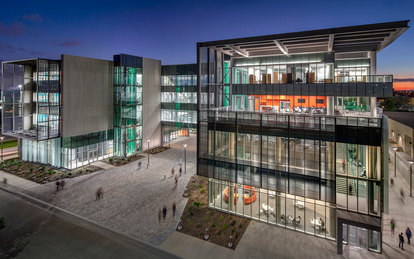University of Texas at Dallas Engineering Building Honored in R&D Magazine's Lab of the Year Competition

The Engineering and Computer Science West building at The University of Texas at Dallas has received a Special Mention for Engineering Labs from R&D Magazine’s prestigious Lab of the Year program. The new 200,000-square-foot, $110 million building is part of the Erik Jonsson School of Engineering and Computer Science, and was designed by SmithGroup, one of the nation’s leading integrated design firms.
Each year R&D Magazine recognizes the top laboratory facilities worldwide representing the best of new and emerging thinking, sustainable practices and creative responses to challenges in the design and construction of modern facilities. The Engineering and Computer Science West building was noted as an exemplar of academic engineering research and teaching facilities. Awards for the Lab of the Year competition were presented April 29, 2019 at the Laboratory Design Conference in Orlando, Florida.
“The Engineering and Computer Science West building is catalyzing growth in our engineering enrollment,” says Inga Musselman, PhD, Vice President for Academic Affairs and Provost at The University of Texas at Dallas, who served as project advocate during design and construction of the award-winning building. “Moreover, UT Dallas students of all majors are making use of the many interaction spaces that are programmed into the building. We are pleased that the jury of the Lab of the Year honored our building for its innovative design.”
The School of Engineering seized a unique opportunity to develop the next-generation facility based upon a new engineering curriculum, all with the goal of becoming a top ranked research institution. Working alongside university stakeholders envisioning the future of their program, SmithGroup designed an engineering building that is a fusion of research and instructional spaces balanced with spaces to spur an outstanding student experience. This design approach is key to enabling the school to meet their goals of attracting and retaining the best and brightest engineering students, researchers and faculty.
The new immersive curriculum ensures the students are engaged in hands-on learning and have access to research from the very beginning of their studies, unlike typical programs where it occurs much later. The building therefore is designed with abundant and highly-visible spaces for collaboration, active research and project-based experimentation. A freshman design lab is prominently located on the first floor, inviting curiosity and observation. A variety of glass-enclosed research labs are stacked along the building’s courtyard, advertising the research and discovery occurring within.
The building itself is an engaging learning tool for students. Not only are all mechanical, electrical, plumbing and technology systems exposed and color-coded, a trend among today’s engineering schools, but all systems are metered to gather and display performance data to building occupants. That monitoring coupled with building systems that are designed for flexibility and reconfiguration enables faculty to allow students to experiment on the building itself—for example, by re-lamping a space to test whether improved energy efficiency can be achieved.
“The new building has boosted UT Dallas’s upward trajectory across all areas of engineering programs, supporting the desire to be viewed as a premier public research institution,” says Thomas Lund, AIA, Regional Program Manager in the Office of Facilities Planning and Construction for The University of Texas System. “UT Dallas will be able to continue propelling future generations of engineering discovery with the adaptability designed into this building.”
The new structure establishes a more prominent gateway to the campus, sited to create a new path for traversing campus and designed to be porous encouraging all students to funnel through its outdoor courtyard. Attuned to its North Texas environment, the new building uses several strategies to ensure its high-performance in its highly variable climate. The building’s orientation, efficient U-shape form and various shading elements leverage daylighting and heat gain intelligently both inside and outside. The courtyard is a breezeway to draw air into and up through a calibrated trellis, while the canopy shades the interior facades and ground. The effect creates a micro-climate of comfortable outdoor zone extending its possible use as instructional or even formal event space.
The building employs several integrated strategies to maximize its performance. Leveraging one of the first chilled air beam systems in this region of Texas, the highly efficient HVAC contributes to the estimated 16% energy reduction that is expected for the building (as compared to a typical facility of the same size designed to code.) The Engineering and Computer Science West Building is LEED Gold certified.
“The design is the physical embodiment of the school’s aspirations for the engineering program and for the campus,” says Mark Kranz, FAIA, a Design Director at SmithGroup and lead designer for the Engineering and Computer Science West building. “The university is ‘walking the walk’ in their new building, evolving how engineering is taught and how to engage students and researchers effectively in a landmark space.”
SmithGroup’s Dallas, Texas office provided integrated design services including architectural design, MEP engineering, laboratory planning, and landscape architecture. Eight SmithGroup-designed laboratories have received recognition as the Lab of the Year, including National Renewal Energy Laboratory Energy Systems Integration Facility (2014) and University of Illinois at Urbana-Champaign Electrical and Computer Engineering Building (2016).
The Beck Group (Dallas, Texas) served as general contractor. Other key design team members include structural engineer JQ Engineering (Dallas, Texas), civil engineer Pacheco Koch (Dallas, Texas), and DataCom Design Group (Dallas, Texas) for audiovisual, IT and acoustical engineering.
For more information about SmithGroup, please visit our Company Fact Sheet.